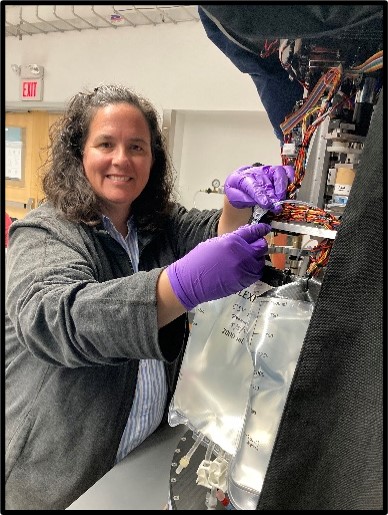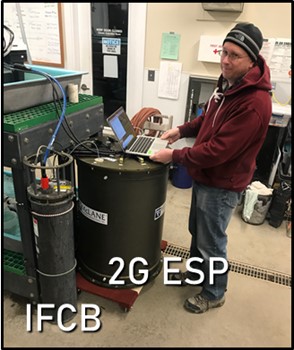
Tina Mikulski calibrates domoic acid sensors on multiple 2G ESPs at the Woods Hole Oceanographic Institution-LOSOS laboratory prior to delivery to their Fall deployment.
National Centers for Coastal Ocean Science (NCCOS) scientists and their partners at the Woods Hole Oceanographic Institution (WHOI) have begun extended co-deployments of Environmental Sample Processors (ESPs) and ImagingFlow Cytobots (IFCBs) at multiple sites for surveillance of toxic Pseudo-nitzschia, a type of plankton, through next spring. Co-deployment of these two complementary technologies provides concurrent, real-time information on changes in cell and toxin concentrations, and enables adaptive triggering of ESP toxin analyses for more targeted, efficient use of reagents. Moreover, this synergistic approach provides resource managers with early warning of bloom development and, most importantly, an ability to track fluctuations in bloom toxicity critical to informing shellfish management decisions.

WHOI colleague David Beaudoin sets up co-deployed IFCB and 2G ESP instruments.
To assure accurate quantification of toxin levels during the upcoming deployments, our team visited the WHOI-LOSOS facility to calibrate the NCCOS-designed domoic acid (DA) sensors onboard three WHOI ESPs, each nicknamed for ease of tracking individual deployments. ESPshorty with its DA sensor was deployed on August 24th, along with an IFCB, on a WHOI-designed pontoon barge for on-the-water surveillance of toxigenic Pseudo-nitzschia cells and DA near an aquaculture site in Salsbury Cove, ME. Two additional ESP instruments with DA sensors onboard are being co-deployed with IFCBs at Bowdoin College Schiller Coastal Studies Center (ESPjake) and URI-GSO pier (ESPdon; deployment pending completion of pier upgrades) for monitoring Pseudo-nitzschia and DA in Harpswell Sound, ME and Narragansett Bay, RI, respectively. ESPshorty is sampling from the barge while conditions are warm enough, and will then be moved into a wetlab at nearby Mount Desert Island Biological Lab to continue its deployment during the winter. ESPjake and ESPdon will monitor DA weekly through the winter months, with sampling frequency increased in response to elevated levels of Pseudo-nitzschia cells or DA as determined by the IFCB or ESP, respectively. Data will be disseminated to regional shellfish managers via an e-mail listserve and later via the WHOI HABhub.
Support for this work is provided in part by the HAB Observing Network-New England project under the NCCOS MERHAB program, a joint effort between NOAA/NCCOS, WHOI, MBARI, and McLane Research Labs, and by the respective deployment partners MDIBL, Bowdoin College, and URI.
 Official websites use .gov
A .gov website belongs to an official government organization in the United States.
Official websites use .gov
A .gov website belongs to an official government organization in the United States. Secure .gov websites use HTTPS
A lock or https:// means you’ve safely connected to the .gov website. Share sensitive information only on official, secure websites.
Secure .gov websites use HTTPS
A lock or https:// means you’ve safely connected to the .gov website. Share sensitive information only on official, secure websites.